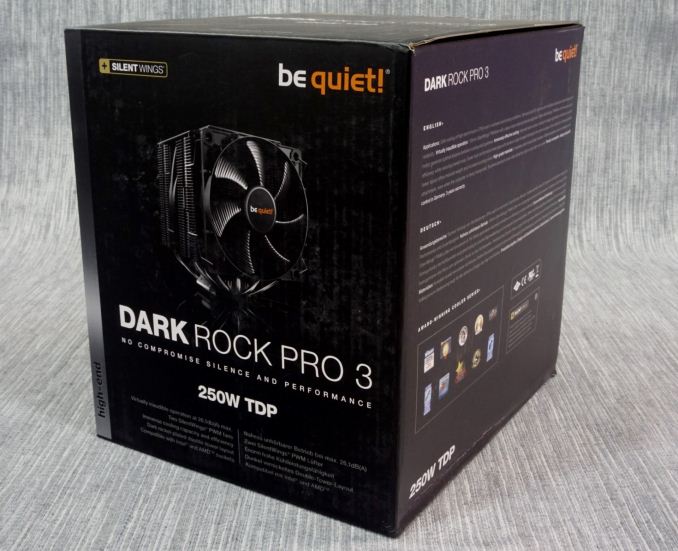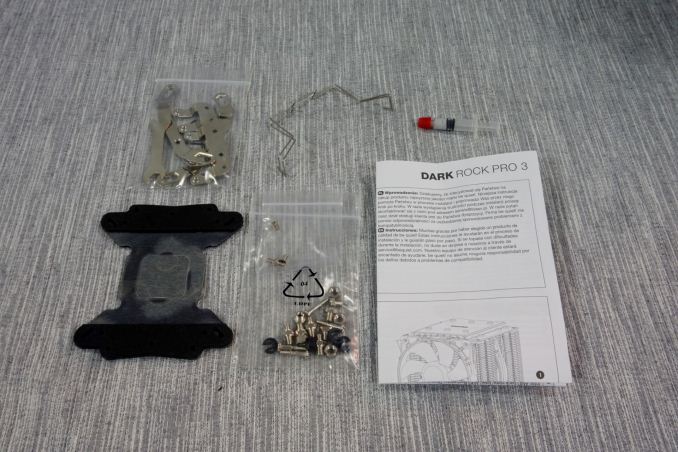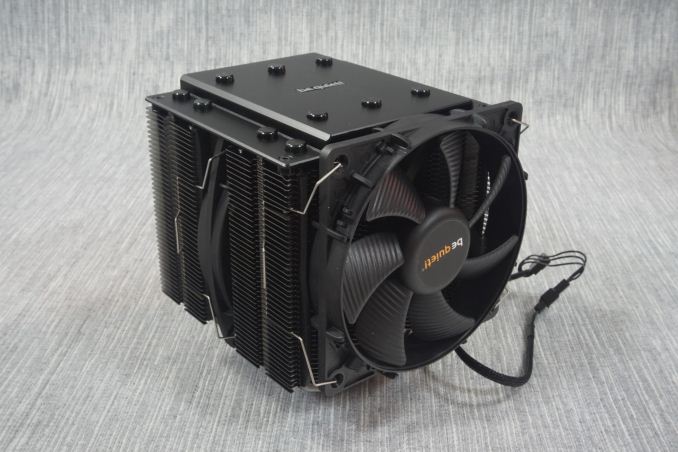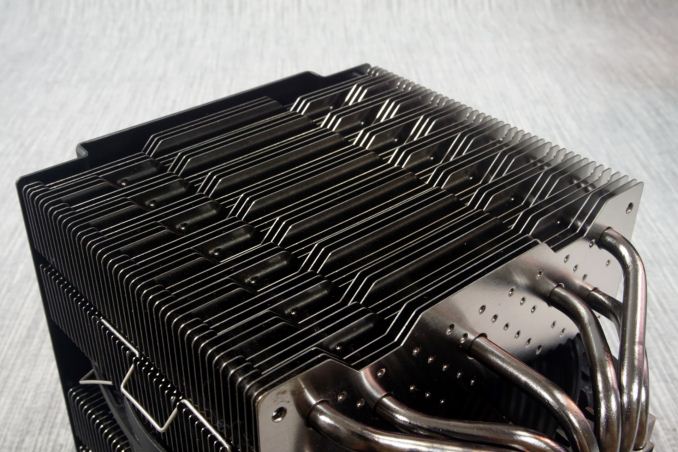Top Tier CPU Air Coolers Q3 2015: 9-Way Roundup Review
by E. Fylladitakis on July 6, 2015 8:00 AM ESTThe Be Quiet! Dark Rock Pro 3
Be Quiet! is a German manufacturer of cooling, case and power PC-related products and one of the few European companies that has managed to push their way into the North American markets. We have checked a few of their power supplies in recent months and most recently saw their new cases and fans at Computex. For this review the company supplied us with the best and largest cooler they currently offer, the Dark Rock Pro 3.
The Dark Rock Pro 3 is supplied into a bizarrely shaped, deep cardboard box, well protected within thick layers of polyethylene foam and cardboard walls. A very basic black and white leaflet with installation instructions and the absolute necessary parts for the mounting of the cooler are supplied, nothing more, with the sole exception of two wire clips for those that want to install a third fan on the cooler.
Much as its name suggests, the Dark Rock Pro 3 is a very large, dark cooler. It is a symmetric dual tower design, meaning that the seven 6 mm heatpipes run through the base and to a separate cooling tower on either side. A metallic black top cover extends across the entire cooling body, covering both towers and the middle cooling fan but leaving the front fan exposed. With the exception of the black top cover, everything else is nickel-plated.
The front of each tower forms a jagged saw tooth design facing the fan that inclines inwards toward the center of the tower, while the rear forms a geometric pattern fashioned from half-octagons. The jagged front is supposed to reduce harsh airflow state transitions and aerodynamic noise, but the rear is most likely shaped for aesthetic purposes only.
The company is using their own SilentWings series fans on the Dark Rock Pro 3. The dimensions of each fan differs, with a 135 mm fan installed between the towers and an 120 mm fan at the front of the cooler. Still, both fans share the same features, such as the decoupling frames, wavy blades and six pole engines with fluid dynamic bearings. They are very high quality and expensive models, yet they are optimized for low noise operation, not high static pressure, which we will see the results of in the testing.
Be Quiet! paid a lot of attention to the base of the Dark Rock Pro 3. It is a very solid construct, forming a small heatsink, possibly to aid the overall performance of the cooler a little bit. The base has been polished to a perfect mirror finish, with no imperfections to be found.















135 Comments
View All Comments
TheJian - Tuesday, July 7, 2015 - link
http://www.anandtech.com/show/6830/cpu-air-cooler-...It is far more impressive than you give it credit for. I easily hit >5ghz on this fan with i4790K.
Shadow7037932 - Tuesday, July 7, 2015 - link
If you're going to extreme OCing, why the hell aren't you on custom water cooling or Dice/LN2?Nfarce - Wednesday, July 8, 2015 - link
Because where I am in overclock, the best air keeps up with the best closed loop kit cooling for far less money.tabascosauz - Monday, July 6, 2015 - link
What farce said is true. At high voltages and overclocks, the 212 EVO breaks down and the dual towers begin to shine.DanNeely - Monday, July 6, 2015 - link
Which with simulated thermal loads ranging from 60-340W should have been made apparent in the course of testing.I would hope and expect that most if not all of these coolers would out perform it, especially at higher loads. But as a de-facto standard budget cooler for people who want something better than Intel's I think it should've been added to the matrix to show how much better these bigger ones performed. A stock Intel cooler should've been included as well for the same purposes (at least at the lower loads; no sense risking burning the test setup by trying to broil 340W through it). Including a mainstream reference point is especially important in this case because E. Fylladitakis's synthetic test load means that we can't cross reference his results with those found elsewhere.
SUpstone - Thursday, October 29, 2015 - link
Totally agree - to get the full picture and to aid comparability with other tests the reference points of the Intel stock cooler (free) and CM 212 EVO (£25) should be included.Flunk - Monday, July 6, 2015 - link
If you buy one of those things on sale I've seen them as low as $30, which if you don't need better cooling, is a good deal. The reason the Hyper 212 EVO is popular is that it's cheaper than most of it's competition and easily available. They're good enough for moderate overclocking on a 1150-series chip so they do fit the bill for a lot of people. Something being popular doesn't make it bad.Pastuch - Monday, July 6, 2015 - link
I have 2 of the original Hyper 212 (Non-evo) on two different I5-2500Ks that have been running super quiet at 4.4ghz for the last 4+ years. No coil whine or bearing degradation on the fans. I paid $20 for each Hyper 212 Evo. The value for the money is amazing. It's an excellent quality reliable product and it's easy to install.I paid $220 for my I5-2500k, 20$ for the Hyper 212 Evo, and $70 for 8gbs of PC 1333 in February of 2011. At 4.4ghz, it's still within 5% as fast as any CPU on the market. Sandy Bridge FOREVER! I'll keep buying video cards. You can waste your money on HSF upgrades for CPUs that become less important every day. DX12 is just going to make the CPU even less useful.
Pastuch - Monday, July 6, 2015 - link
Just to clarify, those are Canadian prices which makes them even more amazing. The new I5-K in Canada is almost $300! No thanks.northward - Monday, July 6, 2015 - link
Remember, the average exchange in 2011 was 1.011 (CAD to USD). It is presently 0.79 (CAD to USD). Assuming US/CAN price parity in 2011, that $220 cooler would cost ~$278, not that far behind the $284 i5 4690K.